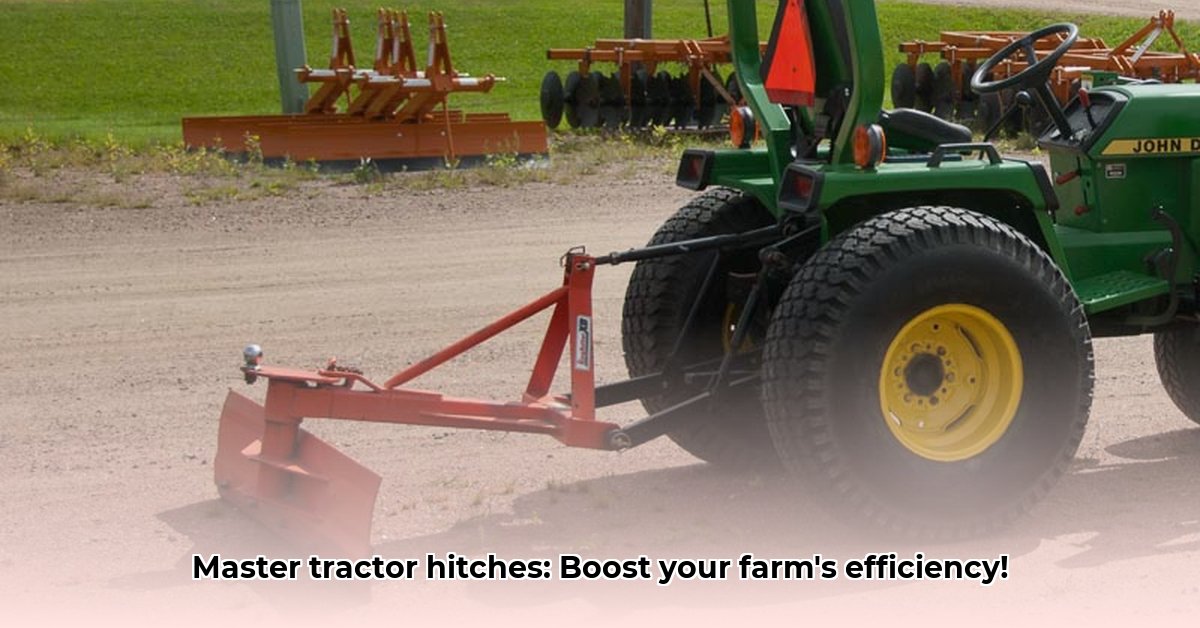
Tractor Hitch Types: A Comprehensive Guide for Enhanced Farm Productivity
Choosing the right tractor hitch is crucial for efficient and safe farm operations. This guide explores the various hitch types, helping you select the best fit for your tractor and tasks. Improper hitch selection can lead to reduced efficiency and even safety hazards, highlighting the importance of careful consideration. For more in-depth information on three-point hitches, check out this helpful resource.
Category 1 Hitches: Ideal for Smaller Tractors and Lighter Implements
Category 1 hitches are commonly found on smaller tractors (under 40 HP). They are designed for lighter-duty implements, such as small mowers, cultivators, and seeders. Their simplicity and wide compatibility make them a popular choice for smaller farms or lighter tasks. Are you primarily focused on smaller-scale operations? A Category 1 hitch may be your optimal solution.
Category 2 Hitches: A Step Up for Medium-Sized Tractors and Heavier Implements
Category 2 hitches are suitable for mid-sized tractors (40-80 HP) and heavier implements like larger tillers, harrows, or hay rakes. Offering increased lift capacity compared to Category 1 hitches, they handle more demanding tasks. Do you need more pulling power for larger implements? A Category 2 hitch provides that added capability.
Category 3 Hitches: Powerful Hitches for Large-Scale Farming Operations
Category 3 hitches are designed for large tractors (over 80 HP) and the most powerful implements, including large plows, disc harrows, and combines. These are built for heavy-duty work and large-scale farming. Remember to always check your tractor's specifications to ensure compatibility before investing in a Category 3 hitch. Its robust design handles the demands of extensive farming operations.
Quick-Hitch Systems: Streamlining Implement Changes
Quick-hitch systems are not hitch types themselves but significant upgrades. They greatly improve efficiency by facilitating quick and easy changing of implements. This simple addition saves considerable time, allowing for seamless transitions between tasks throughout the workday. Many farmers find that the increased efficiency outweighs the initial investment.
Three-Point Hitch: The Foundation of Modern Agricultural Implements
The three-point hitch - a standard design with three connection points - provides stability and control. Its widespread use stems from its reliability and ease of use, ensuring accurate implement positioning for efficient operation. The three-point hitch is a cornerstone of many agricultural implement designs.
Drawbar Hitches: Towing Heavy Loads with Ease
Drawbar hitches are primarily for pulling trailers, wagons, and other heavy loads. They prioritize strength and robustness, making them ideal for transport tasks around the farm. If you frequently need to tow substantial weight, a drawbar hitch is a crucial addition to your tractor setup. It’s a simple yet effective solution for transport needs, ensuring safe and efficient movement of heavy loads.
Choosing the Right Hitch: A Step-by-Step Guide
Selecting the correct hitch depends on your tractor's size and power, and the implements you'll be using. Follow these steps to make the best choice:
- Assess your tractor's horsepower: Determine the horsepower rating to narrow down the suitable hitch categories.
- Identify your implements: List the types of implements used (planters, tillers, harrows, etc.), considering their weight and size.
- Match hitch category to implement and tractor: Consult the table below for guidance. Remember that selecting a hitch with insufficient capacity can lead to accidents and equipment damage.
- Consult your tractor’s manual: Ensure compatibility and safe usage.
| Tractor Horsepower (HP) | Suitable Hitch Type(s) | Typical Implements |
|---|---|---|
| Under 40 | Category 1 | Small planters, cultivators, mowers, small tillers |
| 40-80 | Category 1, Category 2 | Larger planters, tillers, harrows, hay rakes |
| Over 80 | Category 2, Category 3 | Large plows, disc harrows, combines, trailers |
Remember: Prioritize safety! Always adhere to your tractor's manual and use appropriate safety precautions.